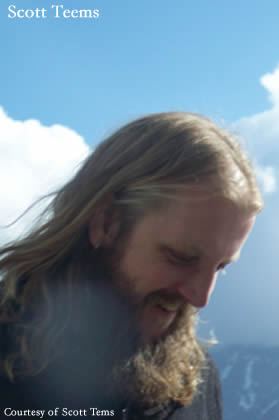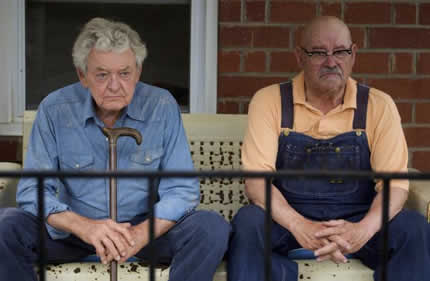Abner Meecham, an aging Tennessee farmer discarded to a nursing facility by his lawyer son, flees the old folks’ home and catches a ride back to his country farm to live out his days in peace. Upon his return, he discovers that his son has leased the farm to Abner’s old enemy and his white trash family. Not one to suffer fools or go down easy, Abner moves into the old tenant shack on the property and declares that he won’t leave until the farm is returned to his possession. But Lonzo Choat, the new tenant, has no intention to move out or give in to the old man’s demands.
This sets up a ruthless grudge match between Abner and Choat, each man right in his own eyes, each too stubborn to give an inch. Angered by his son’s betrayal, and haunted by recurring dreams of his longâ€dead wife, Abner sets about his own path toward reclaiming his
life. Lines are drawn, threats are made, and the simmering tension under the Southern sun erupts, inevitably, into savagery.
Scott Teems is a writerâ€director born and raised in Lilburn, Georgia, a suburb of Atlanta. His screenplay for That Evening Sun previously won the Emerging Narrative Screenplay Award at the IFP Market, and the film marks his feature directorial debut.
Previous writing and directing credits include A Death in the Woods, which won the Kathryn Tucker Windham Storytelling Award at the Sidewalk Moving Pictures Festival, as well as several short films that have screened at film festivals across North America. Scott is also a successful commercial director, helming popular viral video campaigns for corporations such as IBM, Cisco, KB Home, and the Walt Disney Company.
Bijan Tehrani: Was it your reading of “I Hate to See That Evening Sun Go Down” that inspired you to That Evening Sun?
Scott Teems: I read the story about five years ago, and immediately after reading it, I was just compelled to make it into the film. I was drawn to this man who had a great combination of strength and honor. He also had this tunnel vision which prevented him from seeing anyone’s point of view other than his own, which makes him complex and very hard to love. But I empathize with him greatly and his plight, where he comes home and finds someone living in his house. I think that the audience also empathizes with his situation because we want to see him win even though he is not an easy man to love. So the film tests our allegiance as an audience and it pushes us in ways that we don’t expect to be pushed.
BT: Majority of the main characters in American films are young people and in real life the older people are sitting in waiting rooms called nursing homes waiting to die. Can you explain this contrast?
ST: That is an interesting tragedy of American culture for sure, not so much in a lot of foreign cultures where I think that they have it right. Most other cultures treat the elderly with the respect and dignity that they deserve, but in America we look at them as burdens to us young folks who want to live our lives independently without having to worry about our aging parents. Part of the appeal, also, was telling a story of an 80 year old man; I lost my grandfather about ten years ago and I then realized how much I did not seize the opportunity to really learn from him. I did not ask him many questions about their lives and I really regretted that. So this film is a great opportunity to give dignity to an elderly character and really explore and portray them as the complex creatures that they are. So I loved this very real and very flawed elderly character.
BT: One thing which is very clever about the portrayal of the characters is that they are all flawed. ST: Of all three of the main men, Abner is probably the least correct in terms of legality. Abner has the least right of any of them to claim the land, but morally and ethically the land is his. But he goes about getting his land back in the wrong way and he is quite ruthless, belligerent, and brutal towards other people. He comes from a generation where vulnerability is seen as weakness, so he refuses to show any weakness or to see any point of view other than his own. During the golden age of cinema, we have this very black and white portrayal of people: cowboys vs. Indians, good vs. bad; but I feel that this portrayal is wrong because every human is filled with great good. We make mistakes and we have regrets and I think to not show that is very unrealistic.
ST: Of all three of the main men, Abner is probably the least correct in terms of legality. Abner has the least right of any of them to claim the land, but morally and ethically the land is his. But he goes about getting his land back in the wrong way and he is quite ruthless, belligerent, and brutal towards other people. He comes from a generation where vulnerability is seen as weakness, so he refuses to show any weakness or to see any point of view other than his own. During the golden age of cinema, we have this very black and white portrayal of people: cowboys vs. Indians, good vs. bad; but I feel that this portrayal is wrong because every human is filled with great good. We make mistakes and we have regrets and I think to not show that is very unrealistic.
BT: I also greatly admired Hal Holbrook’s performance—describe what it was like working with him.
ST: We had a role for an 80 year old farmer and we didn’t have a lot of choices, so it was quite difficult. There are not many actors who could play this role, especially an actor with name recognition . We needed an actor with a physical presence, an actor who could realistically stand up to these people who were trying to take his land. We also wanted an actor that was real—we told Hal that he wasn’t going to be wearing any make up—and we were going to put him in these raggedy white clothes and show all of his flaws, along with all of his life and history through his face. It wasn’t until I saw Into the Wild that we all really realized that this was the guy, and I think that Sean Penn was able to reimagine Hal in a way that no one had ever seen him before. I saw that strength and virility that would enable him to play the role of Abner. He is such a great actor with so much experience that I realized that my job was to just turn the camera onto him and stay out of his way. He was extremely prepared, the consummate professional, so he’s a pro for sure.
. We needed an actor with a physical presence, an actor who could realistically stand up to these people who were trying to take his land. We also wanted an actor that was real—we told Hal that he wasn’t going to be wearing any make up—and we were going to put him in these raggedy white clothes and show all of his flaws, along with all of his life and history through his face. It wasn’t until I saw Into the Wild that we all really realized that this was the guy, and I think that Sean Penn was able to reimagine Hal in a way that no one had ever seen him before. I saw that strength and virility that would enable him to play the role of Abner. He is such a great actor with so much experience that I realized that my job was to just turn the camera onto him and stay out of his way. He was extremely prepared, the consummate professional, so he’s a pro for sure.
BT: How did you come up with the visual style of the film?
ST: This is my first feature film; I have made several short films over the years so I have just been honing my visual style. I really enjoy observing character place and environment; I love the details and wide shots. The way to make that work in a two hour film is to get the script to be very tight; you can have artificial devices but the story is moving forward because the script is moving forward. I also try to capture a feeling of the place—I want the audience to feel like they are out there on this isolated farm with these people, just trying to get a sense of that and just being still and being quite.
BT: Thanks you for your time and I wish you a lot of success with this beautiful film.

